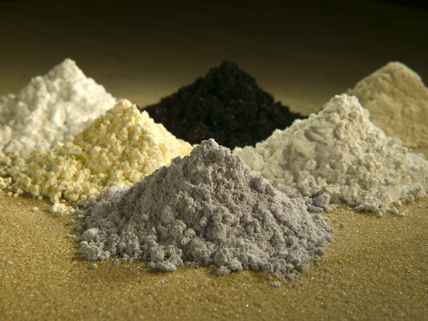What do high-end baseball bats, smart phones, European currency, hybrid cars, and night-vision goggles have in common? They all need rare-earth elements (REEs) for their manufacture. The 17 elements—with tongue-numbing names like yttrium, praseodymium, neodymium, and dysprosium—aren’t actually rare, but their properties make them extremely valuable. For example, some of the elements glow bright colors, while others make magnets or medicines more powerful. Industry uses a huge amount of REEs; a single hybrid car may contain 20 pounds of lanthanum, and a wind turbine may use 700 pounds of neodymium. REEs matter also because they have given China, which is already an economic powerhouse, additional clout in the global economy.
There are deposits of REEs in other countries, but 97 percent of REE processing is done in China, which restricts REE exports. The idea behind the export limit was that if other countries couldn’t buy enough REEs to supply their automotive and high-tech industries, they would have to develop processing plants in China. In response, the United States, Mexico, and the European Union filed a suit with the World Trade Organization (WTO), claiming that China’s restrictions on the export of rare earths was illegal. China claimed that its exports had been reduced because the previous production level was unsustainable and damaging to the environment. It is true that extracting REEs from their ores is extremely polluting. Critics noted, however, that China’s environmental record is very bad, and the country’s new-found sensitivity was a ruse.
On July 5 the World Trade Organization agreed with the plaintiffs, declaring China’s limits on REEs exports illegal. The WTO has no police power, though, and cannot force its members to comply with its rulings. Meanwhile, researchers are stepping up the recycling of REEs to help fill the gap resulting from Chinese restrictions. The search is also on for new sources of REEs. U.S. mines that had been closed may reopen. Japan recently found billions of tons of REEs. But there’s a problem: the deposits are at the bottom of the Pacific Ocean.
Image credit: USDA/ARS/Peggy Greb
Related Links
- The Scramble for Europe?
Check out this blog describing China’s use of its economic power to force open European investment opportunities.
(Source: The Economist, June 27, 2011) - China to Reform Rare Earth Exports after WTO
Explore details of China’s response to the WTO ruling.
(Source: Reuters, July 6, 2011) - Asia Today: China Takes Heat on Exports, Japan Finds Rare Earth Stash
Watch a video of Wall Street Journal commentators discussing the rare-earth exports issue.
(Source: Wall Street Journal, July 5, 2011) - Global Production of Rare-Earth Oxides, 1950–2007
View a graph presenting global production of rare-earth oxides by major producers.
(Source: Environmental Science & Technology; accessed August 1, 2011) - The WTO
Read more about the World Trade Organization on its official Web site.
(Source: World Trade Organization; accessed August 1, 2011)






Wow, your post makes mine look fleebe. More power to you!
and less power to u cuz men have more rights
Testing
boring
XD
what
i wonder how REEs work ?????
Yet, Sep/Oct vehicle sales held up prttey well in China, so it seems the problem is more with the Eurozone and US, which are both importing less and exporting more, especially Germany which is being aided by a very cheap Euro.Oil alone represents 15% of global trade with Brent at 105 dlrs, right? Global trade is around 15 trillion a year, trade in oil is around 65 mbpd, that gives us 2.5 trillion a year. But if the price of oil goes up 25% to $131/bbl., that makes the oil trade 3.1 trillion dlrs a year and 20% of world trade. World trade seems to have gone up 500 billion or 3% to 15.5 trillion dlrs, but what has changed except the price of oil?The value of oil to world trade together with price volatility due to resource constraints seems to be creating large distortions in the trade data: such as a phantom trade boom in 2008 during a recession.Of course, there is also the anomaly of measuring world trade in US dollars. This makes world trade seem to boom when the dollar is weak, such as in 2008 and contract when the US dollar is strong.The correlation between the oil price and the value of world trade seems to come in part from the fact that we are measuring both in US dollars which are themselves fluctuating in value.If we measured trade in a “basket of currencies” we could get rid of some of the dollar fluctuation issues but we would still be left with the oil price fluctuation issues. Hmmm.